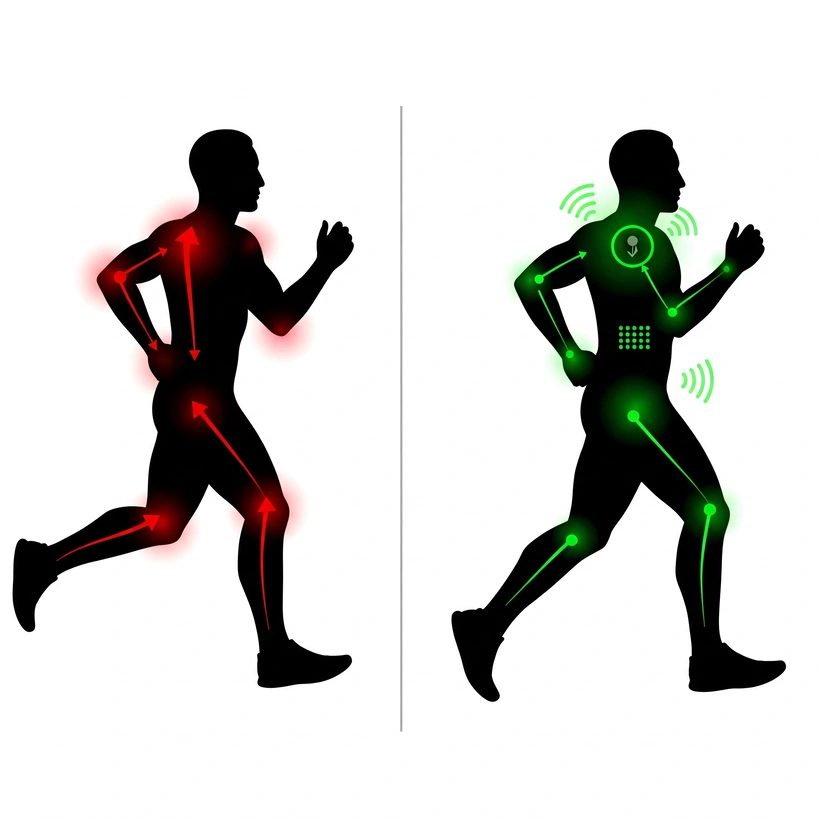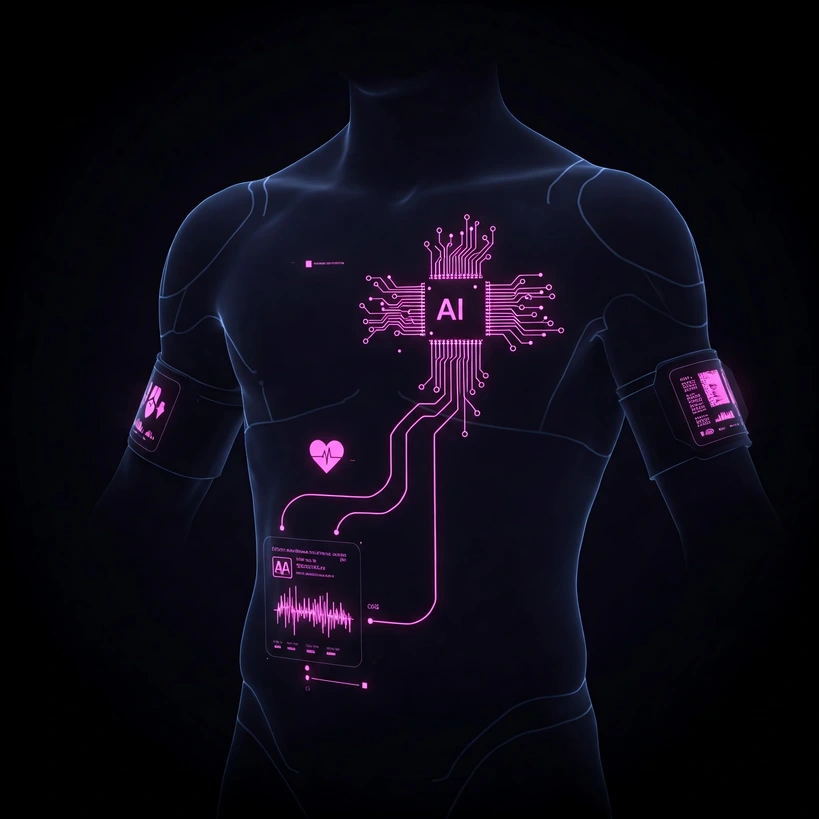We’ve come a long way in running technology. GPS watches track our pace and distance, heart rate straps monitor our effort, and apps chart our progress. These tools are undoubtedly useful, offering valuable data points. But what if your gear could do more than just log data? What if it could understand how you run, coach you in real-time, and act as an intelligent partner dedicated to making you a better, healthier runner?
This isn’t science fiction. Welcome to the next frontier: the AI running shirt. It represents a paradigm shift from passive data collection to active, personalized guidance woven directly into the fabric you wear. Forget just knowing your heart rate; imagine your shirt analyzing your muscle engagement, correcting your form on the fly, and predicting fatigue before it sets in. This is the future of wearable running technology, offering unprecedented potential to optimize performance, prevent injuries, and create a truly symbiotic relationship between runner and gear.
Deconstructing the “Smart” Shirt: More Than Just Fabric
So, what exactly makes an AI running shirt “smart”? It’s the powerful fusion of advanced materials, seamlessly embedded sensor technology, and sophisticated Artificial Intelligence algorithms working in concert.
The foundation is an advanced smart fabric – lightweight, breathable, moisture-wicking, and comfortable, as you’d expect from high-performance gear. But woven into this textile is an intricate network of miniaturized sensors:
- Core Biometrics: Going beyond basic optical sensors, expect ECG-accurate heart rate monitoring and precise respiration rate/depth tracking using integrated strain sensors across the chest.
- Movement & Form Dynamics: Tiny, strategically placed accelerometers and gyroscopes capture granular data on your posture, cadence, torso rotation, arm swing, and ground contact time. This forms the basis for detailed form analysis.
- Muscle Activity (EMG): Perhaps the most revolutionary aspect is the integration of Electromyography (EMG sensors). These measure the electrical activity produced by skeletal muscles, allowing the AI to understand which muscles are firing, how hard they’re working, when they’re fatiguing, and if there are critical imbalances between left and right sides.
- Biochemical Sensing: Emerging technology allows for real-time sweat analysis via specialized threads or patches. This could provide insights into hydration levels, electrolyte loss, and even estimate lactate threshold shifts during a run.
- Temperature Monitoring: Sensors tracking skin temperature can help the AI factor heat stress into its analysis and potentially estimate core body temperature changes.
All this data needs to be collected and transmitted, typically via Bluetooth Low Energy, to a paired device (phone/watch) or potentially a small onboard processor. Powering these systems efficiently and ensuring durability through countless runs and washes remain key engineering challenges, but solutions involving flexible batteries and even kinetic energy harvesting are rapidly evolving.

The AI “Brain”: Transforming Raw Data into Running Wisdom
Collecting data is one thing; turning it into actionable wisdom is where the AI truly shines. The sophisticated algorithms analyze the torrent of information from the wearable sensors to provide insights far beyond simple metrics.
- Real-time Coaching & Feedback: This is the game-changer. Based on your goals and its continuous analysis, the AI provides immediate, personalized feedback. Imagine subtle haptic feedback (targeted vibrations) on your shoulder if you start slouching, or a quiet audio cue via connected headphones suggesting “Increase cadence slightly” or “Engage core.” This real-time coaching helps you make corrections mid-stride, ingraining better habits.
- Predictive Insights & Injury Prevention: AI excels at pattern recognition. It can detect subtle deviations in your gait, muscle firing patterns, or heart rate variability that signal neuromuscular fatigue before you consciously feel it. By identifying asymmetries and imbalances highlighted by the biomechanics running shirt capabilities, the system can provide injury prevention AI alerts, warning you about increased risk for common running ailments and suggesting corrective actions or rest. It helps you understand your running economy – how efficiently you use energy – and guides you towards improvement.
- Personalized Performance Optimization: Post-run, the companion app becomes your data hub. Dive deep into detailed charts mapping your form, muscle usage, heart rate zones, and efficiency throughout the run. The AI provides personalized training insights, comparing your performance to previous runs and suggesting targeted exercises or stretches. Based on sweat analysis or effort levels, it can even provide tailored hydration and nutrition cues.
- Environmental & Contextual Adaptation: Future iterations could integrate external data like weather conditions, air quality, or terrain profile (from GPS). Imagine the AI advising a slightly easier pace on a hot, humid day or suggesting specific breathing techniques when running in poor air quality.
The Runner’s Experience: Your Invisible Coach & Data Analyst
Using an AI smart shirt feels fundamentally different from glancing at a watch. The feedback is designed to be intuitive and non-intrusive. Haptic nudges are subtle reminders, not jarring alerts. Audio cues are quiet suggestions, not constant chatter. The goal is to guide, not distract, allowing you to stay focused on your run while receiving expert input.
This creates a symbiotic partnership. You run, the shirt senses, the AI analyzes and advises, and you adapt. It’s like having an expert coach running alongside you, providing tailored insights based on your unique physiology and real-time condition. Post-run, the detailed analytics empower you to understand your body and progress like never before, moving far beyond the passive data logging of current devices.
Pushing the Boundaries: Creative & Futuristic Applications
The potential doesn’t stop there. Researchers and developers are exploring even more exciting possibilities:
- “Flow State” Detection: Can AI identify the unique physiological signature of being “in the zone” and provide subtle cues to help you maintain that state of peak performance and enjoyment?
- Predictive Performance Modeling: Imagine the AI accurately predicting your finish time during a race based on your real-time data and historical performance.
- Mental Game Insights: Correlating stress markers (like HRV) with perceived effort could offer insights into your mental resilience and focus during challenging runs.
- Adaptive Materials: Could AI control micro-vents or fabric properties to optimize cooling or warmth based on your body temperature and ambient conditions?
- Holistic Health Integration: Connecting AI coaching apparel data with sleep trackers, nutrition logs, and even AR glasses could provide a truly comprehensive view of your health and performance ecosystem.

Navigating the Hurdles: Challenges on the Road Ahead
While the vision is compelling, bringing truly effective and accessible AI running shirts to the mass market involves overcoming significant challenges:
- Technical Barriers: Ensuring sensor accuracy, long-term durability (especially through washing), sufficient battery life, and seamless data transmission are paramount.
- Cost & Accessibility: Initial versions will likely be expensive. Making this technology affordable for everyday runners is crucial for widespread adoption.
- Data Privacy & Security: Handling sensitive biometric data requires robust security measures and transparent privacy policies to build user trust.
- User Acceptance & Trust: Runners need to trust the AI’s insights. The system must be intuitive, avoid information overload, and not foster an unhealthy over-reliance on technology.
- Standardization: Interoperability between different brands and platforms will be important for a seamless user experience.
The Finish Line View: Future Outlook & Impact
AI-powered smart running shirts are not just a gimmick; they represent a significant evolution in fitness technology. While some advanced features are still under development, core functionalities like real-time form feedback and enhanced biometric tracking are rapidly approaching market readiness.
Initially, we might see elite athletes leveraging this tech for marginal gains. However, as costs decrease and technology matures, the benefits for competitive amateurs and recreational runners – particularly in injury prevention and personalized guidance – could be immense. This technology fits squarely within the broader trend of smart clothing and personalized digital health, promising a future where our apparel actively contributes to our well-being and performance goals.
Run Smarter, Run Healthier, Run Connected
The potential of the AI running shirt is transformative. Imagine fewer injuries, breaking through performance plateaus, and having a deeper understanding of your body’s mechanics, all thanks to the clothes you wear. It’s about shifting from guesswork to data-driven insights, guided by an intelligent partner working silently to help you achieve your best.
The next time you lace up your shoes, picture a future where your shirt isn’t just fabric, but your personal running coach, data analyst, and biomechanist, all rolled into one. That future, powered by Artificial Intelligence, is closer than you think. Are you ready to upgrade your running partner?
Acknowledgements and Further Reading
This blog post was created by synthesizing information from a broad knowledge base covering artificial intelligence, wearable technology, sports science, and current trends in running gear, guided by the specific requirements of the prompt. While individual articles were not browsed live for the creation of this specific text, the concepts discussed reflect publicly available information and ongoing research in these fields. For readers interested in exploring these fascinating topics further and keeping up with the latest advancements, the following resources are valuable places to start:
- Wired – Wearables News & Reviews: Offers insights into the latest trends and reviews in wearable technology.
- The Verge – Wearable Technology Section: Provides news and analysis on smart clothing and other wearable devices.
- SportTechie: Focuses specifically on the intersection of sports and technology, including AI applications.
- Google Scholar: A resource for finding academic papers and research studies on biomechanics, AI in sports, and sensor technology (requires navigating research literature).
Continuously exploring these resources can provide deeper insights into the rapidly evolving world of AI-powered smart apparel and its impact on athletic performance and health.

About the Author
Lost Pace is an ultramarathon runner, shoe-tester and the founder of umit.net. Based year-round in Türkiye’s rugged Kaçkar Mountains, he has logged 10,000 + km of technical trail running and completed multiple 50 K–100 K ultras.
Blending mountain grit with data, Lost analyses power (CP 300 W), HRV and nutrition to craft evidence-backed training plans. He has co-written 260 + long-form guides on footwear science, recovery and endurance nutrition, and is a regular beta-tester of AI-driven coaching tools.
When he isn’t chasing PRs or testing midsoles, you’ll find him sharing peer-reviewed research in plain English to help runners train smarter, stay healthier and finish stronger.
Ultrarunner · Data geek · Vegan athlete

